80286 Motherboards
80286-based motherboards were around before any standardisation of socketed CPUs came about. This page looks into some of these old 286 boards. The 80286 introduced us to the concept of protected memory areas (each application able to run in its own area of memory), and effectively doubled or tripled the performance of the average PC. The 286 was a great step up from a PC or XT, both through higher clock speeds and 24-bit addressing.
The vast majority of 286s ran at 12 MHz, though some later ones that came out during the 386 era ran at 16 or 20 MHz. There is even the odd rarity that went up to 25 MHz!
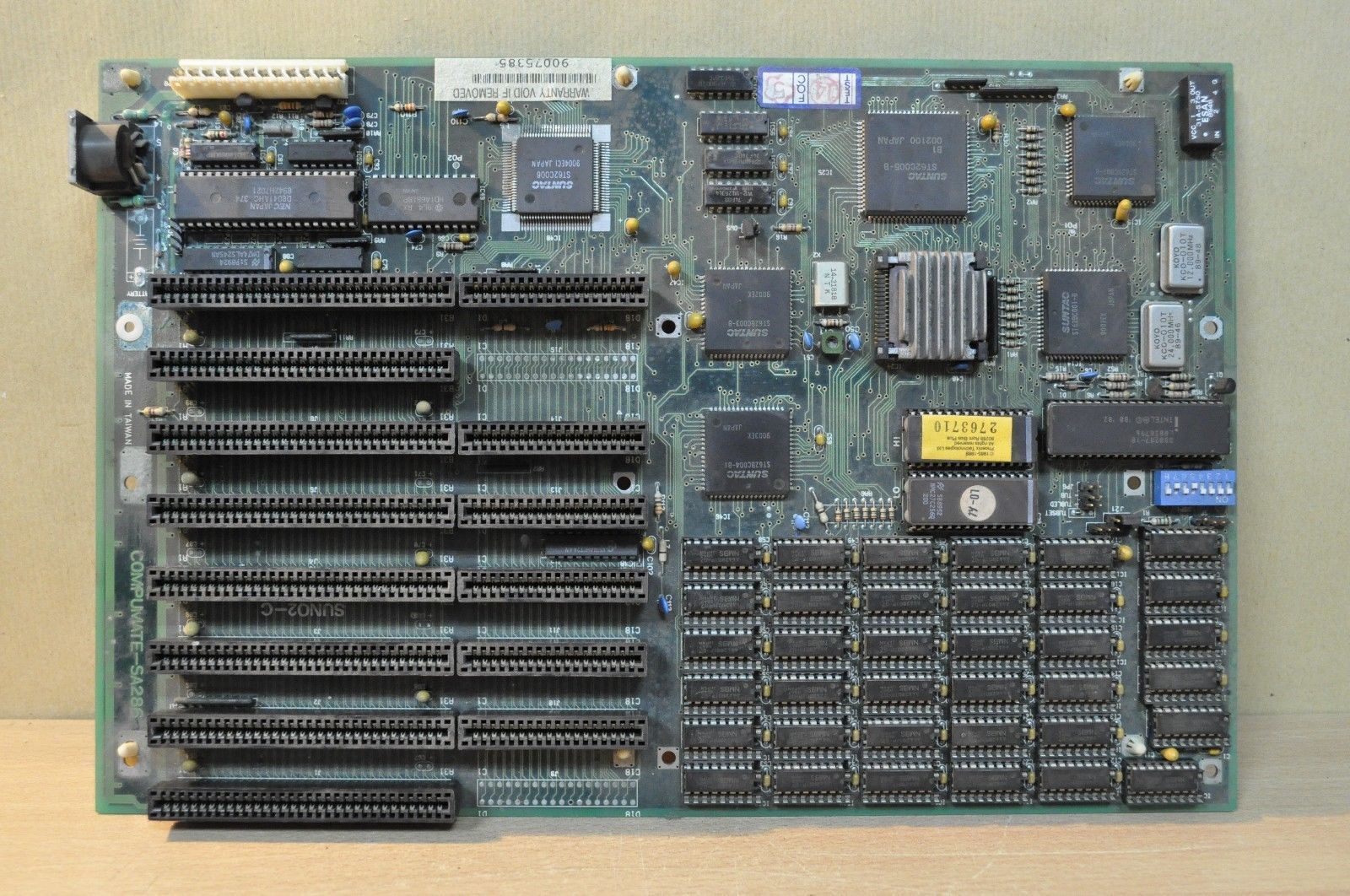 Compumate SA286
Compumate SA286
This motherboard is from the Compumate SA286. It has a 10 MHz 80286 CPU as well as an 80287 math coprocessor.
Onboard memory is 640 KB.
It uses the six-chip Suntac ST62 chipset. What's a little odd for this older 286 board is why there is a heatsink on top of the CPU, which were were never considered to run hot, especially not at 10 MHz.
 Octek DCS-286
Octek DCS-286
This board is one I have. It runs an Intel 80286 at 10 MHz and has the NEAT chipset from Chips & Technologies.
As you can see, this is another board that has suffered corrosion as a result of the coin cell leaking battery acid over time. The board has since been cleaned and still functions.
It has six 16-bit ISA expansion slots and two 8-bit slots. For more information, head over to my full review of this motherboard.
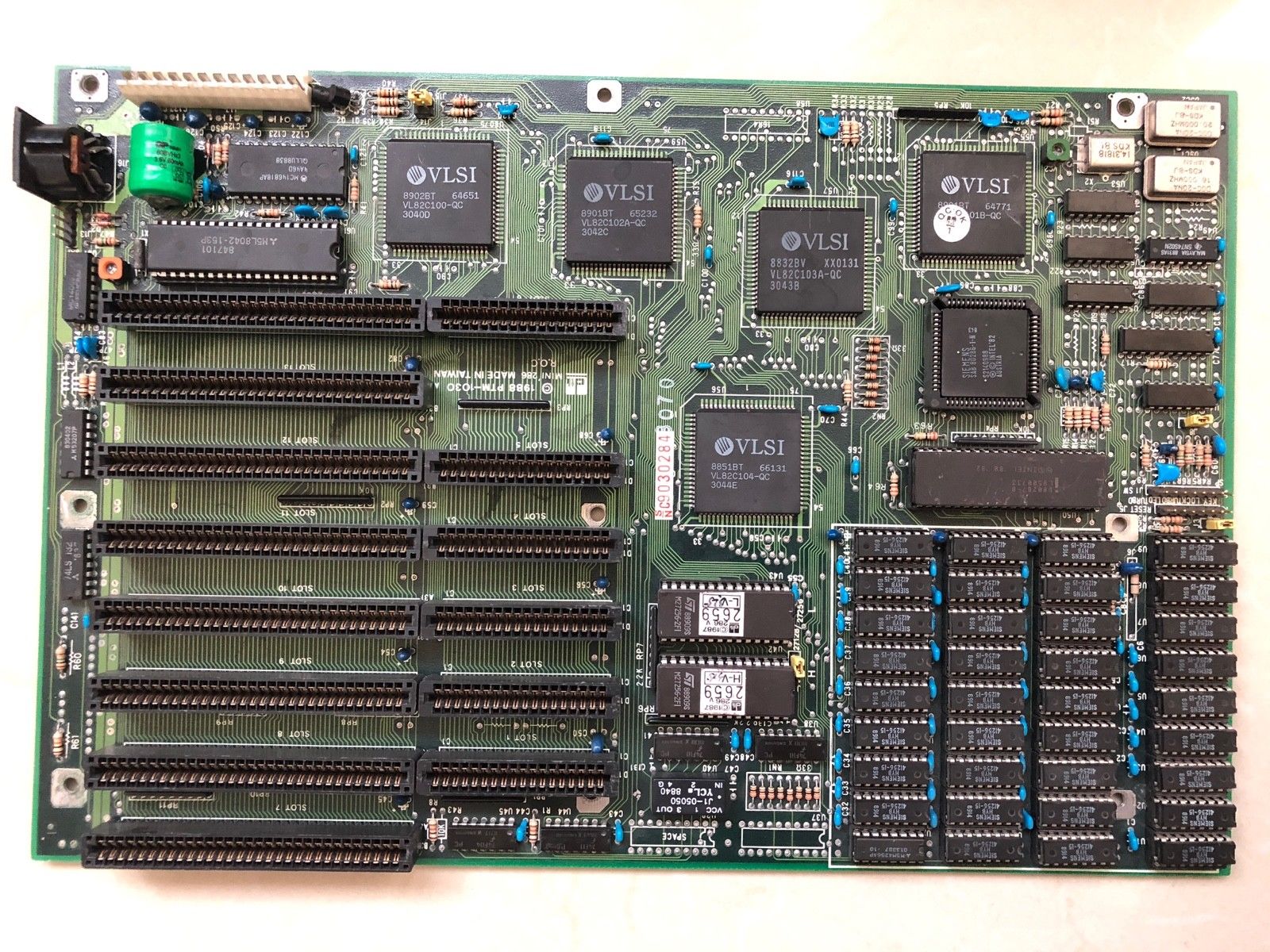 DTK PTM-1030 Mini-286
DTK PTM-1030 Mini-286
Another older 286 mainboard from 1988, this one is from a Datatech Enterprises (DTK) 286 computer. It has a five-chip VLSI chipset and runs a Siemens-branded 80286 at 10 MHz.
This one also has an installed 80287-8 math coprocessor.
Memory onboard is 1 MB of DRAM chips across two banks - bank 0 consists of the two rows of DRAMs furthest to the right, with bank 1 being the two closer to the high and low BIOS chips.
I'm not sure why the PC this came in was called the "Mini-286" though - with this board size, it's still pretty large.
Stason.org has the layout and configuration information on this board.
Here's another image of the PTM-1030.
 DTK Technology Tech-1234
DTK Technology Tech-1234
This board from Datatech Enterprises Co. (aka DTK) follows the design of the IBM PC-AT, with five 16-bit ISA expansion slots and three 8-bit. It supports an Intel 80286 running at 12 MHz.
The DTK Tech-1234 was one of the first motherboards to use a "chipset" (a means of combining a lot of chips into far fewer to simplify board design and be more cost-effective to manufacture). This board uses the NEAT chipset from Chips & Technologies.
According to the manual, it can support up to 5 MB of main memory. The BIOS is stored in two ROMs at locations U14 (high) and U15 (low). These are 32 KB each.
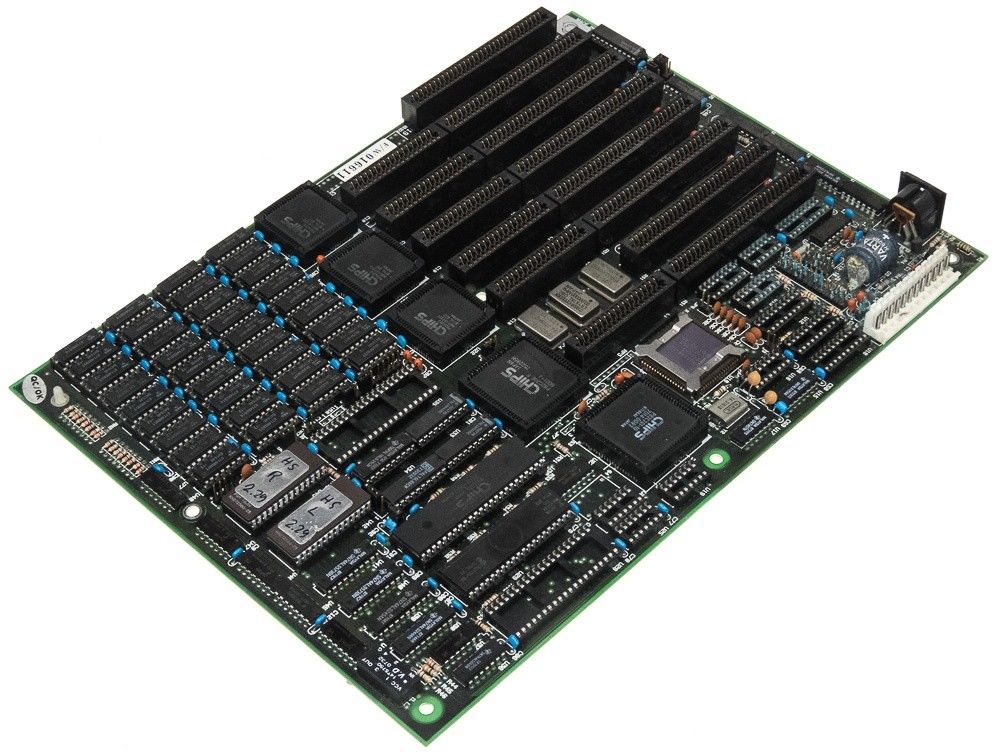 ELT-286
ELT-286
This is suprisingly compact, with a very dense layout, primarily due to the five-chip C&T chipset, which is an 82C201.
Memory is provided via the four banks of DRAM sockets and this is not expandable without an ISA RAM card.
It has a socketed 80286-10 CPU.
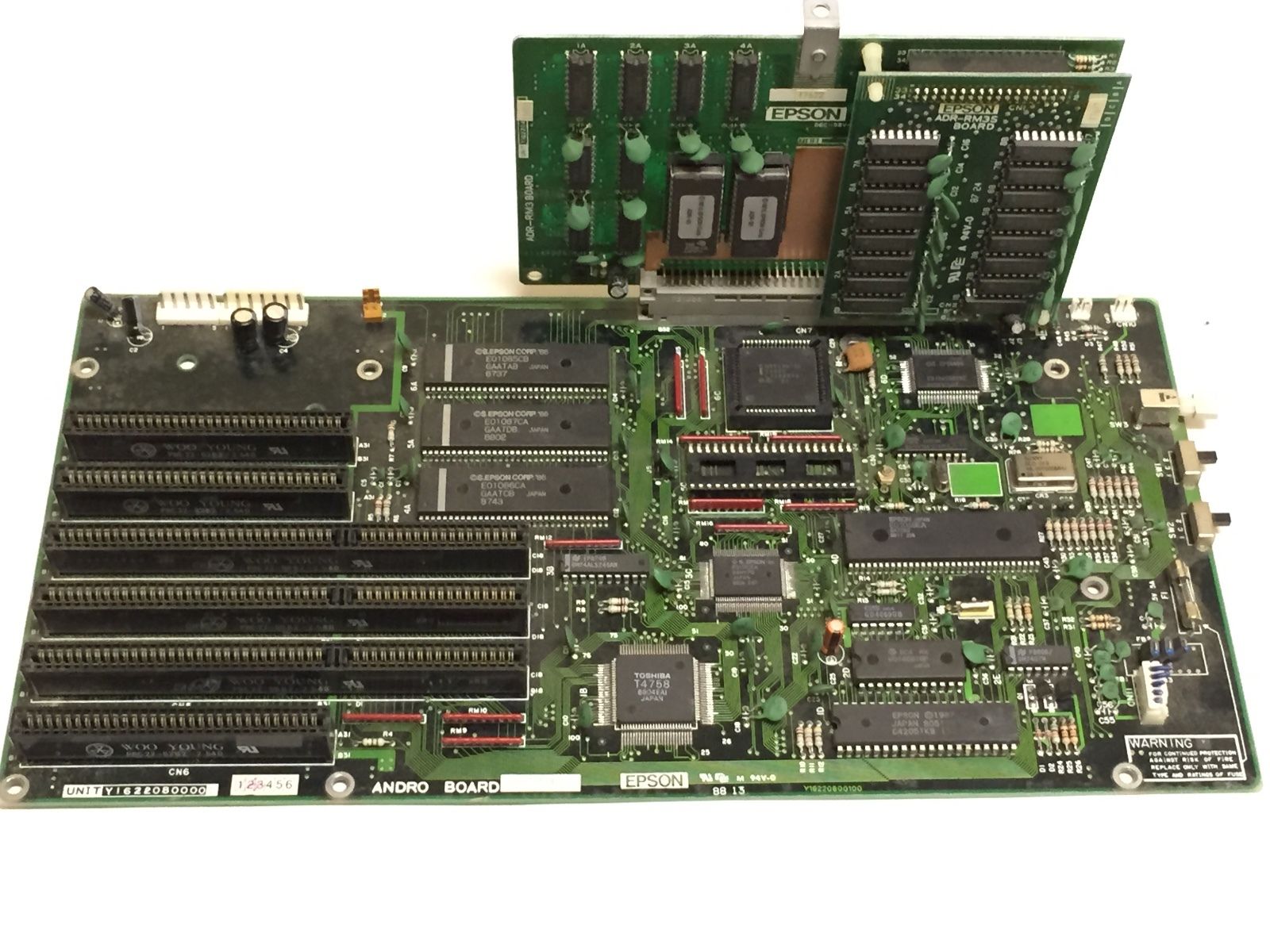 Epson Andro
Epson Andro
This board is from an Epson Andro PC. With it you see the Epson ADR-RM3 daughterboard that appears to have the ROM BIOS and main memory.
It has an Intel 80286-12 CPU and three 16-bit and three 8-bit ISA slots.
 Epson Anta
Epson Anta
This board is from an Epson AX PC. With it you see the Epson ANT-RM daughterboard that appears to have the ROM BIOS and main memory.
The main motherboard appears to be separatable from the expansion slots and is joined via a pinned socket. I'm not sure what the purpose of this is (having them separate), since the main P8/P9 power connectors are on the expansion slot side, so one is useless without the other.
 Headland HT12
Headland HT12
Headland produced their own motherboards for a while, but were more famous for their motherboard chipsets. This Baby AT board uses the Headland HT12 chipset, which with its EMS driver can provide an EMS interface in addition to conventional, XMS and Int15 extended memory all at the same time!
This board has a 286 socket which is great, currently populated with a Harris 80286-16. Most 80286 motherboards use two crystal oscillators: one for the CPU which tends to be x2 the CPU frequency, and a second for the FPU (usually the same clock as that chip's frequency, i.e. x1).
The memory layout is two banks, with each either populated with DRAMs or 30-pin SIMMs. Because there are only two banks you cannot populate both bank 0s or both bank 1s, but you can mix DRAMS and SIMMs. Maximum memory is 4 MB.
The User manual for another HT12 board very similar to this is here.
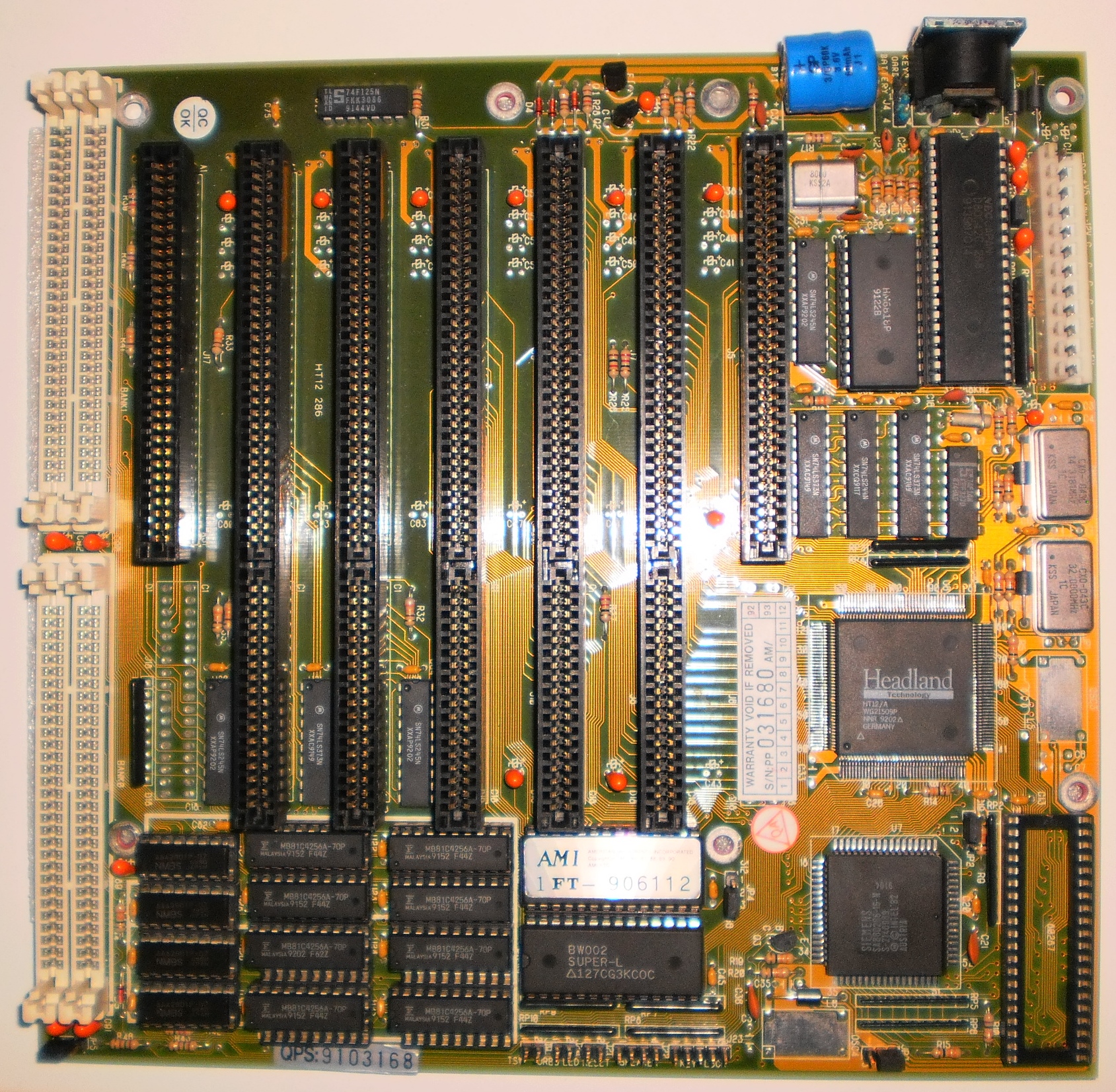 Headland HT12
Headland HT12
Another 286 motherboard that uses the Headland HT12 chipset (see above). This one has an interesting design with its 4 SIMM slots to the far left of the board. It was quite common during the period when we were moving from DRAM chips to SIPPs and SIMMs for a board to come with a base amount of memory in DRAM sockets, but with empty SIPP or SIMM sockets for expansion later on.
This one has a Siemens-branded 80286 running at 16 MHz soldered-in.
 Headland HT12
Headland HT12
Yet another Baby AT 286 motherboard that uses the Headland HT12 chipset (see above).
This one has a Harris 80286 CPU running at 20 MHz soldered-in, so a nice fast 286. It also has 1 MB of RAM installed in its four 30-pin SIMM slots. Presumably it supports 4 MB SIMMs for a maximum capacity of 16 MB.
It has a Phoenix BIOS Plus v3.10.01, dated 1989.
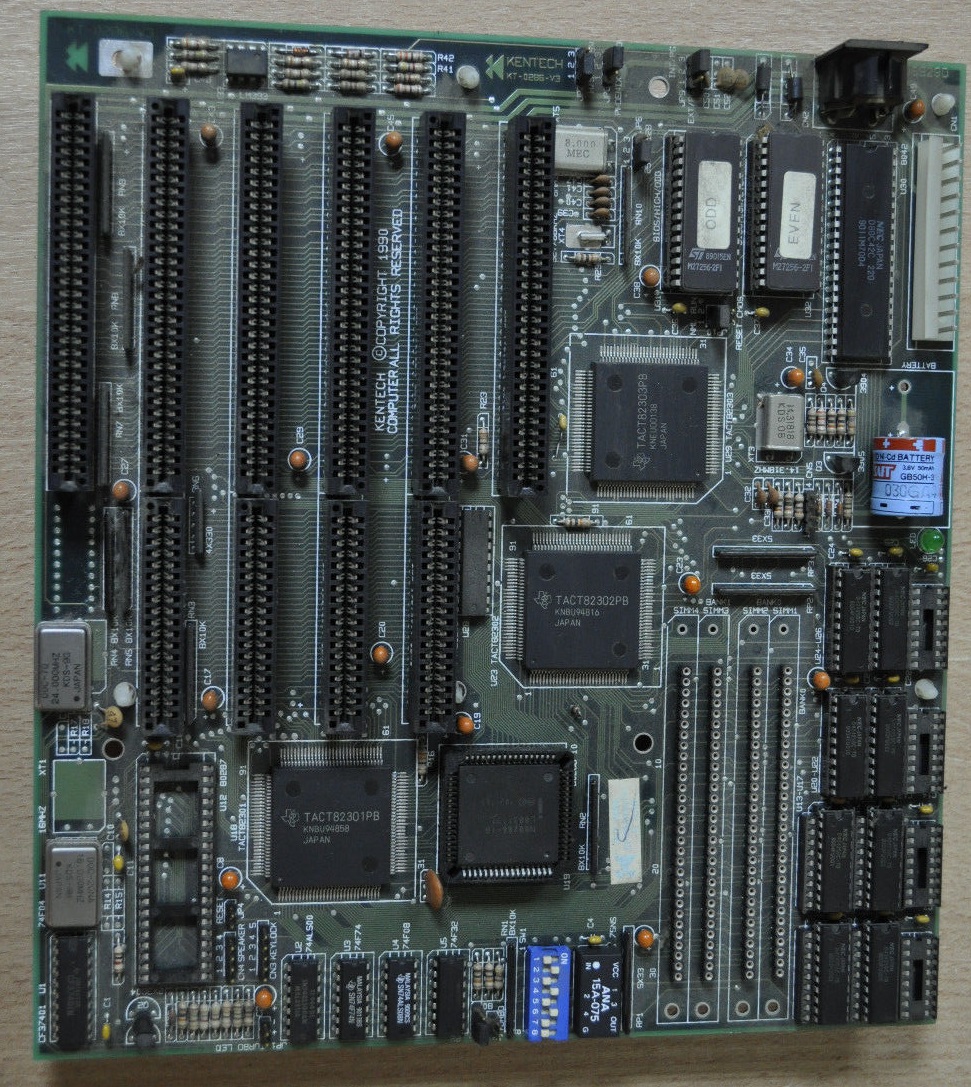 Kentech KT-0286 v3
Kentech KT-0286 v3
This 286 board has a 3-chip chipset from Texas Instruments, the TACT-82000. It has a socketed 80286-10 CPU, 4 banks of SIPP slots for memory, and for expansion it offers four 16-bit ISA slots and two 8-bit slots.
The keyboard controller is an NEC-branded 8042.
The BIOS is the 286 Modular BIOS v3.04 from Award Software.
 Magitronic P233
Magitronic P233
This Baby AT 286 board uses the popular Suntac 62 chipset. Designed for the 80286-12 CPU, it supports zero wait states and up to 16 MB of RAM via 2 banks of socketed DRAM chips. For expanded memory support, use the SEMS.SYS driver - this works on all Suntac 62 chipset 286 boards. The board will work with a wide variety of BIOSs including AWARD, Pheonix, AMI and ERSO.
The DIP switches are as follows:
SW1=CPU speed select high/low, SW2=Monitor type (colour/mono), SW3=Parity enabled/disabled, SW4=EMS port address (0E8h/098h), SW5=BIOS type select (27128/27256).
The jumpers are as follows:
JP5=wait state selection (closed=0 waits, open=1 wait)
JP6=reset switch
JP7=turbo switch
JP8=turbo LED
JP9=turbo select control (1&2 closed=keyboard-controlled, 2&3 closed=controlled by SW1)
JP10=speaker
JP20=power LED and keylock
User Manual
ROMs (high and low)
A very similar board is here, which supports a maximum of 4 MB RAM via its SIPP slots:
 MicroSys PA286
MicroSys PA286
This Baby AT 286 board uses a chipset I cannot identify - SA1, or PE168AK. It has 1 MB of socketed DRAM chips but also supports more via its four 30-pin SIMM slots offering 2 banks. A socketed AMD 80286-16 CPU and for expansion it offers five 16-bit ISA slots and one 8-bit slot.
The AMI BIOS is dated 1990.
If the SA1 chipset supports faster clock speeds than 16 MHz, my guess is the rest of the board would handle it too. Overall, a very tidy modern 286 motherboard.
More Images
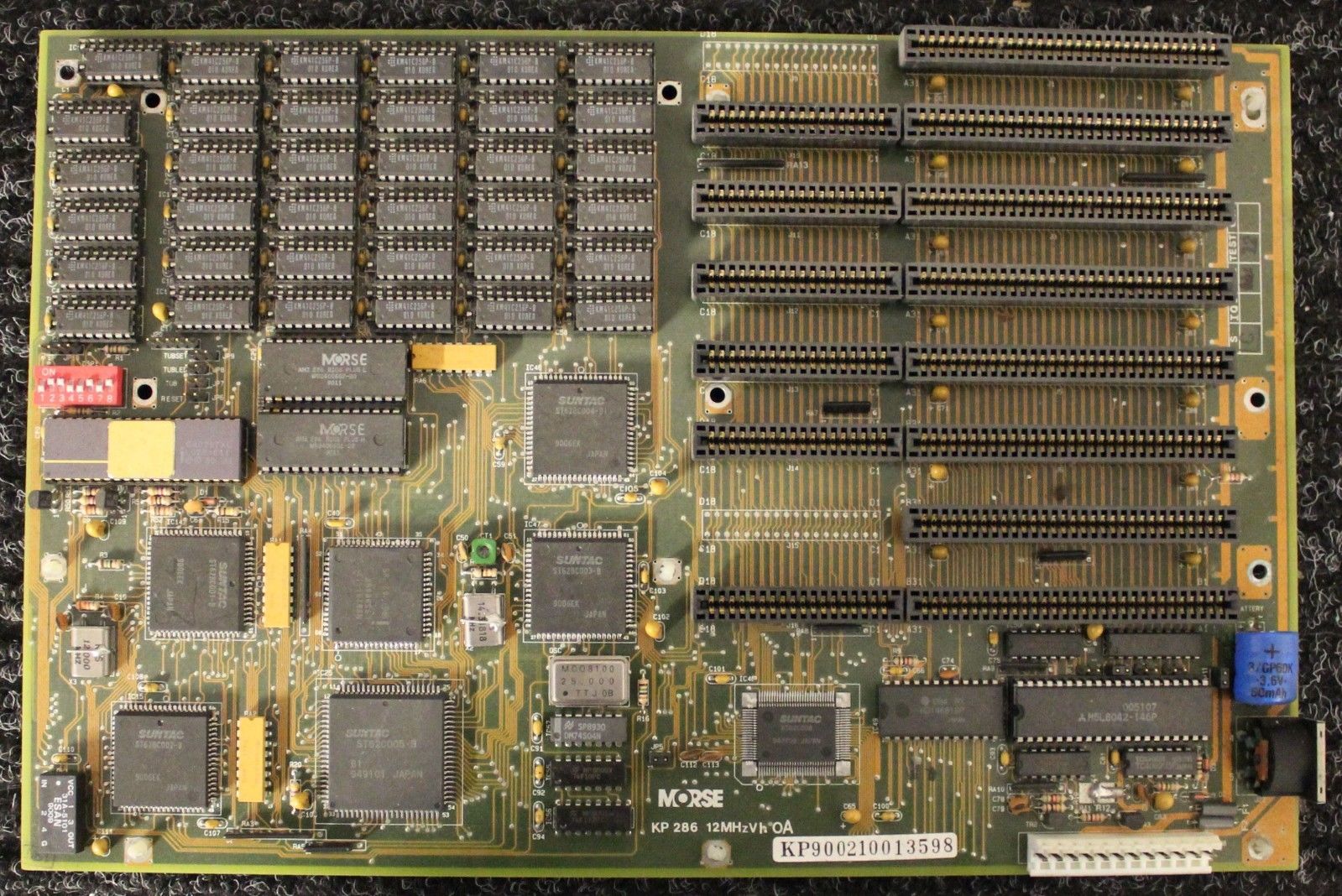 Morse KP 286
Morse KP 286
This 286 board uses the Suntac ST62 6-chip chipset. It has a soldered-in Intel 80286-12 CPU, 1.5 MB of DRAM ICs for memory, and for expansion it offers six 16-bit ISA slots and two 8-bit slots.
The chipset chips are ST62C001, ST62C002, ST62C003, ST62C004 and ST62C005.
The board also appears to have a socketed Intel 80287 math coprocessor installed.
 Schneider Euro AT
Schneider Euro AT
Schneider built and resold home computers and PCs for Amstrad UK. This board is from the Euro AT which was their third foray into the PC business.
It uses a Headland Technology chipset - I've also seen these with a G2 chipset and since Headland acquired G2 at some point, this probably coincided with that time period. It comes with a Siemens-branded 12 MHz 80286 CPU. On the back you can see the external ports, which from the top are: Floppy disk drive, printer port, monitor, and serial port.
 Tandon TM7000
Tandon TM7000
This board manufactured by OKI is from a Tandon TM7000 PC, released in 1989.
It has a rather slow Intel 80286-8 CPU and 1 MB of RAM which is not expandable.
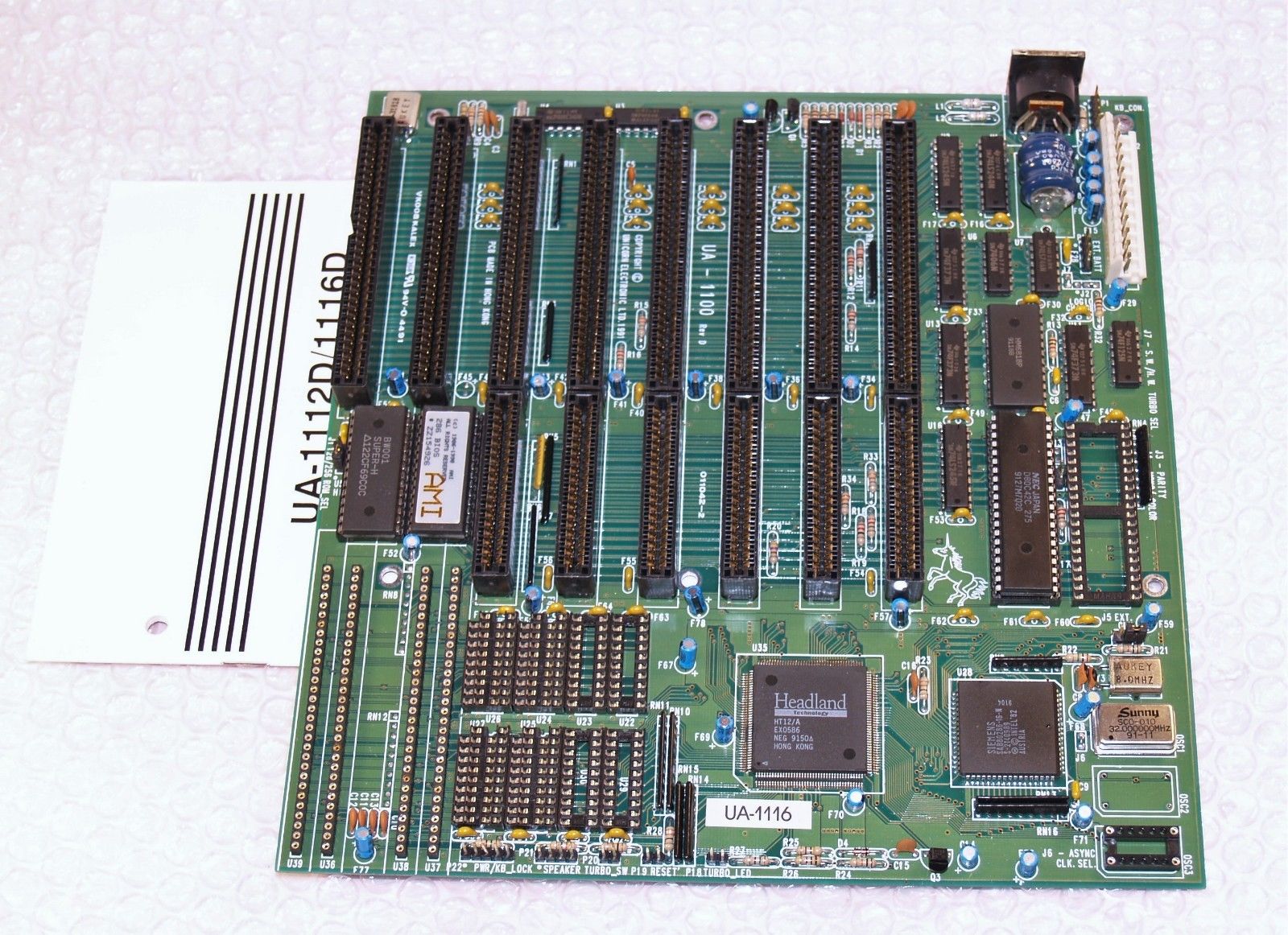 Unique UA-1116
Unique UA-1116
This 1992 286 board is very compact, made by the company Unique with model number UA-1116.
It has a Headland Technologies HT12/A single-chip chipset, an AMI BIOS dated 1990, and has four SIPP sockets for memory expansion but also comes with DRAM sockets.
The CPU is a soldered-in Siemens-branded 80286-16.
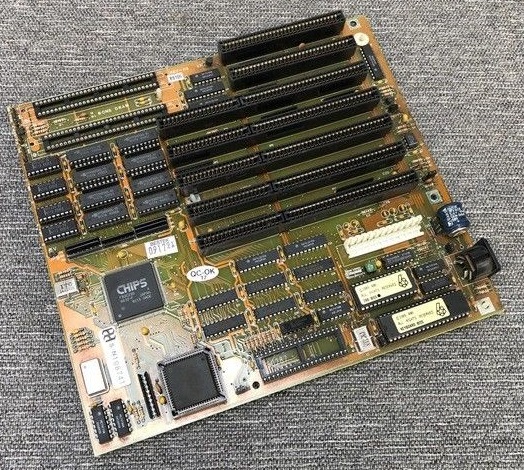 Unknown 286 (C&T chipset)
Unknown 286 (C&T chipset)
This 286 board is unidentified. It has a single-chip chipset from Chips & Technologies, an AMI BIOS dated 1989 and AMI keyboard controller, and has four 80ns SIPP sockets for memory.
It has a socketed Intel 80286-12.
BioStar 286 (VLSI chipset)
This 286 board from 1990 uses the VLSI 82C2xx chipset, which is able to run at up to 20 MHz. Sadly it doesn't come with any SIMM slots, so you're forced to try to find DRAM chips to expand the memory, and for a 20 MHz system you ideally need the fastest ones, 60ns or 70ns, to avoid lots of wait states.
This one has an AMD-branded 802L86-16.
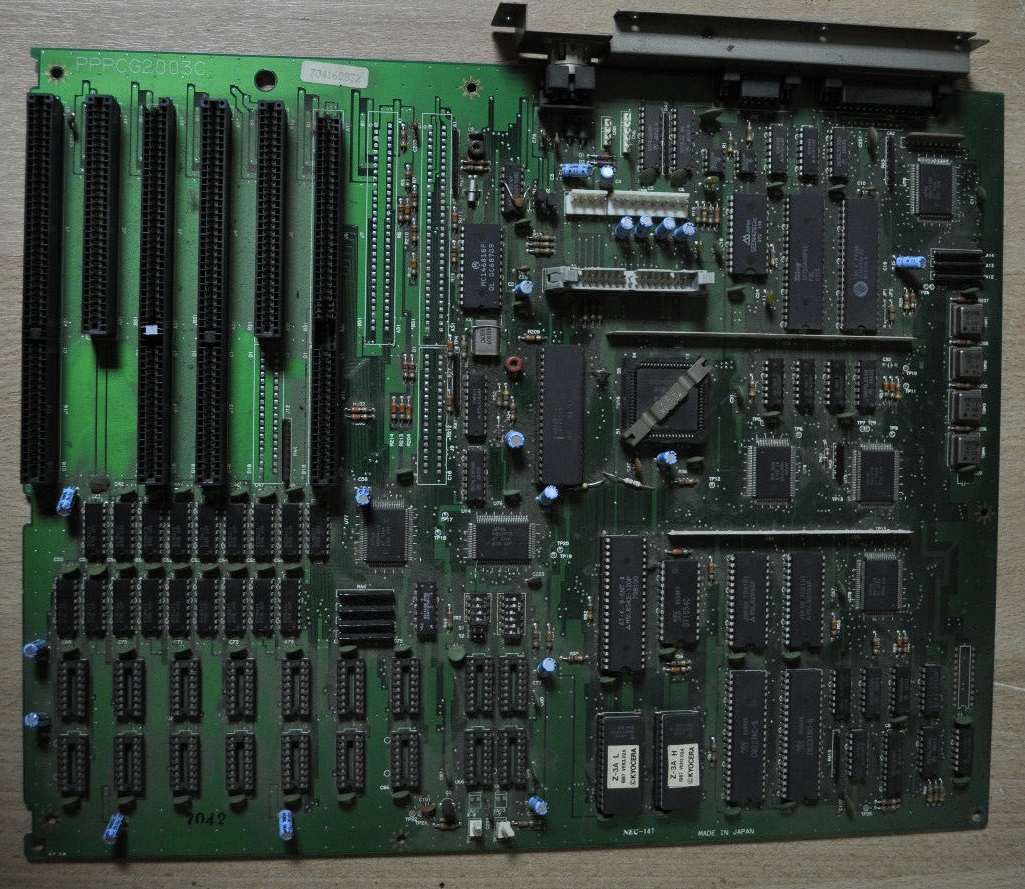 Victor 2951-2
Victor 2951-2
This very old 286 board has discrete ICs (no chipset here). It has a socketed Siemens-branded 80286 CPU, 512 KB of DRAM ICs for memory, and for expansion it offers four 16-bit ISA slots and two 8-bit slots.
The BIOS appears to be from Kyocera.
The realtime clock chip is a Motorola MC146818P.
The silkscreen has NEC-141 etched onto it.




